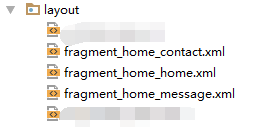FragmentTabHostBottomDemo【FragmentTabHost + Fragment实现底部选项卡】
版权声明:本文为HaiyuKing原创文章,转载请注明出处!
前言
使用FragmentTabHost实现底部选项卡效果。
备注:该Demo主要是演示FragmentTabHost的一些设置和部分功能,实际中需要参考其他Demo。
效果图

代码分析
1、该Demo中采用的是FragmentTabHost的布局方案之一【命名为非常规布局写法】;【建议使用常规布局写法,见《FragmentTabHostTopDemo【FragmentTabHost固定宽度且居中】》】
2、未使用自定义的FragmentTabHost;【建议使用自定义的FragmentTabHost,见《FragmentTabHostUnderLineDemo【FragmentTabHost带下划线】》】
原因是FragmentTabHost切换时执行的是attach/detach,而不是show/hide。而atach触发的执行顺序:attach()->onCreateView()->onActivityCreated()->onStart()->onResume()
使用hide()方法只是隐藏了fragment的view并没有将view从viewtree中删除,随后可用show()方法将view设置为显示。
3、ContactFragment演示的是:使用FragmentTabHost时,Fragment之间切换时每次都会调用onCreateView方法,导致每次Fragment的布局都重绘,无法保持Fragment原有状态。
小结:对于2和3,都是解决切换fragment的时候重载的问题,两种方案各有利弊,选择其中一个即可。
4、演示设置选项卡区域的自定义宽度和高度;
5、演示初始化时、切换时传参;【切换时传参,可能一般用不到】
6、自定义选项卡子项类【获取底部选项卡的布局实例并初始化设置、更新文字颜色】;【这个思路参考别人的,思路比较好】【更新每个选项卡的背景需要额外写另外的方案,见《FragmentTabHostTopDemo【FragmentTabHost固定宽度且居中】》】
7、演示点击选项卡子项不切换到相应的fragment,而是打开一个新的界面;【用作个别情况】
使用步骤
一、项目组织结构图


注意事项:
1、 导入类文件后需要change包名以及重新import R文件路径
2、 Values目录下的文件(strings.xml、dimens.xml、colors.xml等),如果项目中存在,则复制里面的内容,不要整个覆盖
二、导入步骤
将选项卡子项布局文件tab_bottom_item.xml文件复制到项目中

<?xml version="1.0" encoding="utf-8"?> <!-- 底部选项卡区域的子选项卡布局文件 --> <RelativeLayout xmlns:android="http://schemas.android.com/apk/res/android" android:layout_width="match_parent" android:layout_height="wrap_content" android:background="@color/tab_bg_normal" android:gravity="center" > <!-- android:checkMark="?android:attr/listChoiceIndicatorMultiple"代表多选 android:checkMark="?android:attr/listChoiceIndicatorSingle" 代表单选 该属性不添加的话,不会显示方框或者圆点 --> <!-- android:drawableTop的属性值使用drawable目录下的selector选择器 --> <!-- android:tag="tag1"用于checkedTextview的索引 --> <!-- 选项卡的内容(图片+文字)类似RadioButton --> <!--android:textAlignment="center" 文本居中--> <CheckedTextView android:id="@+id/bottomtab_checkedTextView" android:tag="tag1" android:layout_width="wrap_content" android:layout_height="wrap_content" android:gravity="center" android:text="" android:textSize="@dimen/tab_text_size" android:textColor="@color/tab_text_normal" android:textAlignment="center" /> </RelativeLayout>
将图片资源和selector文件复制到项目中【后续可根据实际情况更换图片】


在colors.xml文件中添加以下代码:【后续可根据实际情况更改背景颜色、文字颜色值】
<?xml version="1.0" encoding="utf-8"?> <resources> <color name="colorPrimary">#3F51B5</color> <color name="colorPrimaryDark">#303F9F</color> <color name="colorAccent">#FF4081</color> <!-- *********************************底部选项卡区域********************************* --> <!-- 底部选项卡底部背景色 --> <color name="tab_bg_normal">#00000000</color> <color name="tab_bg_selected">#00000000</color> <!-- 底部选项卡文本颜色 --> <color name="tab_text_normal">#8a8a8a</color> <color name="tab_text_selected">#38ADFF</color> </resources>
在dimens.xml文件中添加以下代码:【后续可根据实际情况更改底部选项卡区域的高度值、文字大小值】
<resources> <!-- Default screen margins, per the Android Design guidelines. --> <dimen name="activity_horizontal_margin">16dp</dimen> <dimen name="activity_vertical_margin">16dp</dimen> <!-- *********************************底部选项卡区域********************************* --> <!--底部选项卡高度值--> <dimen name="tab_bottom_background_height">56dp</dimen> <!-- 底部选项卡文本大小 --> <dimen name="tab_text_size">14sp</dimen> <dimen name="tab_medium_text_size">16sp</dimen> <dimen name="tab_larger_text_size">18sp</dimen> <dimen name="tab_larger_small_text_size">20sp</dimen> </resources>
在strings.xml文件中添加以下代码:【后续可根据实际情况更改底部选项卡的文字内容】
<resources> <string name="app_name">FragmentTabHostBottomDemo</string> <!-- *********************************底部选项卡区域********************************* --> <string name="home_function_home">首页</string> <string name="home_function_message">消息</string> <string name="home_function_contact">我的</string> </resources>
至此,选项卡子项的布局所需的文件已集成到项目中了。
三、使用方法
在Activity布局文件中引用FragmentTabHost【此Demo采用的是非常规(自己命名的,以便于区分)的布局写法】
<?xml version="1.0" encoding="utf-8"?> <LinearLayout xmlns:android="http://schemas.android.com/apk/res/android" xmlns:tools="http://schemas.android.com/tools" android:id="@+id/activity_main" android:layout_width="match_parent" android:layout_height="match_parent" android:orientation="vertical" tools:context="com.why.project.fragmenttabhostbottomdemo.MainActivity"> <!-- 碎片切换区域 --> <FrameLayout android:id="@+id/center_layout" android:layout_width="match_parent" android:layout_height="0.0dp" android:layout_weight="1"> </FrameLayout> <!-- 分割线 --> <View android:layout_width="match_parent" android:layout_height="1dp" android:background="#cfcfcf"> </View> <!-- 底部选项卡区域 --> <android.support.v4.app.FragmentTabHost android:id="@+id/tab_bottom_ftabhost_layout" android:layout_width="match_parent" android:layout_height="wrap_content" > <!-- 这个FrameLayout其实是切换区域 且其id必须为@android:id/tabcontent --> <FrameLayout android:id="@android:id/tabcontent" android:layout_width="match_parent" android:layout_height="0dp" android:layout_weight="1" /> </android.support.v4.app.FragmentTabHost> </LinearLayout>
创建需要用到的fragment类和布局文件【后续可根据实际情况更改命名,并且需要重新import R文件】


特别的是ContactFragment类,用来演示使用FragmentTabHost时,Fragment之间切换时每次都会调用onCreateView方法,导致每次Fragment的布局都重绘,无法保持Fragment原有状态。【解开注释代码,注释选中的代码,会看到不一样的效果】
package com.why.project.fragmenttabhostbottomdemo.fragment; import android.os.Bundle; import android.util.Log; import android.view.LayoutInflater; import android.view.View; import android.view.ViewGroup; import android.widget.TextView; import com.why.project.fragmenttabhostbottomdemo.R; /** * Created by HaiyuKing * Used 首页界面——我的碎片界面 */ public class ContactFragment extends BaseFragment{ private static final String TAG = "ContactFragment"; /**View实例*/ private View myView; private TextView tv_homef; /**传递过来的参数*/ private String bundle_param; //重写 public View onCreateView(LayoutInflater inflater, ViewGroup container, Bundle savedInstanceState) { //使用FragmentTabHost时,Fragment之间切换时每次都会调用onCreateView方法,导致每次Fragment的布局都重绘,无法保持Fragment原有状态。 //http://www.cnblogs.com/changkai244/p/4110173.html if(myView==null){ myView = inflater.inflate(R.layout.fragment_home_contact, container, false); //接收传参 Bundle bundle = this.getArguments(); bundle_param = bundle.getString("param"); } //缓存的rootView需要判断是否已经被加过parent, 如果有parent需要从parent删除,要不然会发生这个rootview已经有parent的错误。 ViewGroup parent = (ViewGroup) myView.getParent(); if (parent != null) { parent.removeView(myView); } //普通写法,如果换成这个方式,那么bundle_param的值不会发生任何变化 // myView = inflater.inflate(R.layout.fragment_home_contact, container, false); // //接收传参 // Bundle bundle = this.getArguments(); // bundle_param = bundle.getString("param"); return myView; } @Override public void onActivityCreated(Bundle savedInstanceState) { // TODO Auto-generated method stub super.onActivityCreated(savedInstanceState); //初始化控件以及设置 initView(); //初始化数据 initData(); //初始化控件的点击事件 initEvent(); } @Override public void onResume() { super.onResume(); } @Override public void onPause() { super.onPause(); } @Override public void onDestroy() { super.onDestroy(); } /** * 初始化控件 */ private void initView() { tv_homef = (TextView) myView.findViewById(R.id.tv_homef); } /** * 初始化数据 */ public void initData() { Log.w("tag","{iniData}bundle_param" + bundle_param); tv_homef.setText(tv_homef.getText() + "--" + bundle_param); } /** * 初始化点击事件 * */ private void initEvent(){ } public void setBundle_param(String bundle_param) { this.bundle_param = bundle_param; } }
在Activity中使用如下【继承FragmentActivity或者其子类】
package com.why.project.fragmenttabhostbottomdemo; import android.content.Context; import android.graphics.drawable.Drawable; import android.os.Bundle; import android.support.v4.app.Fragment; import android.support.v4.app.FragmentTabHost; import android.support.v4.content.ContextCompat; import android.support.v7.app.AppCompatActivity; import android.util.Log; import android.view.View; import android.widget.CheckedTextView; import android.widget.LinearLayout; import android.widget.TabHost; import android.widget.Toast; import com.why.project.fragmenttabhostbottomdemo.fragment.ContactFragment; import com.why.project.fragmenttabhostbottomdemo.fragment.HomeFragment; import com.why.project.fragmenttabhostbottomdemo.fragment.MessageFragment; import java.util.ArrayList; public class MainActivity extends AppCompatActivity { private FragmentTabHost mBottomFTabHostLayout; //选项卡子类集合 private ArrayList<TabItem> tabItemList = new ArrayList<TabItem>(); @Override protected void onCreate(Bundle savedInstanceState) { super.onCreate(savedInstanceState); setContentView(R.layout.activity_main); initTabList(); initFTabHostLayout(); setFTabHostData(); initEvents(); } /** * 初始化选项卡数据集合*/ private void initTabList() { tabItemList.add(new TabItem(this,getResources().getString(R.string.home_function_home), R.drawable.home_tab_home_selector,HomeFragment.class)); tabItemList.add(new TabItem(this,getResources().getString(R.string.home_function_message), R.drawable.home_tab_message_selector,MessageFragment.class)); tabItemList.add(new TabItem(this,getResources().getString(R.string.home_function_contact), R.drawable.home_tab_contact_selector,ContactFragment.class)); } /** * 初始化FragmentTabHost*/ private void initFTabHostLayout() { //实例化 mBottomFTabHostLayout = (FragmentTabHost) findViewById(R.id.tab_bottom_ftabhost_layout); mBottomFTabHostLayout.setup(this, getSupportFragmentManager(), R.id.center_layout);//最后一个参数是碎片切换区域的ID值 // 去掉分割线 mBottomFTabHostLayout.getTabWidget().setDividerDrawable(null); //设置选项卡区域的自定义宽度和高度 LinearLayout.LayoutParams params = new LinearLayout.LayoutParams(LinearLayout.LayoutParams.MATCH_PARENT, getResources().getDimensionPixelSize(R.dimen.tab_bottom_background_height)); mBottomFTabHostLayout.getTabWidget().setLayoutParams(params); } /**设置选项卡的内容*/ private void setFTabHostData() { //Tab存在于TabWidget内,而TabWidget是存在于TabHost内。与此同时,在TabHost内无需在写一个TabWidget,系统已经内置了一个TabWidget for (int i = 0; i < tabItemList.size(); i++) { //实例化一个TabSpec,设置tab的名称和视图 TabHost.TabSpec spec = mBottomFTabHostLayout.newTabSpec(tabItemList.get(i).getTabTitle()).setIndicator(tabItemList.get(i).getTabView()); // 添加Fragment //初始化传参:http://bbs.csdn.net/topics/391059505 Bundle bundle = new Bundle(); bundle.putString("param","初始化传参"); mBottomFTabHostLayout.addTab(spec, tabItemList.get(i).getTabFragment(), bundle); // 设置Tab按钮的背景(必须在addTab之后,由于需要子节点(底部菜单按钮)否则会出现空指针异常) mBottomFTabHostLayout.getTabWidget().getChildAt(i).setBackgroundResource(R.drawable.tab_bg_selector); } //默认选中第一项 mBottomFTabHostLayout.setCurrentTab(0); tabItemList.get(0).setChecked(true); } private void initEvents() { //选项卡的切换事件监听 mBottomFTabHostLayout.setOnTabChangedListener(new TabHost.OnTabChangeListener() { @Override public void onTabChanged(String tabId) { //重置Tab样式 for (int i = 0; i< tabItemList.size(); i++) { TabItem tabitem = tabItemList.get(i); if (tabId.equals(tabitem.getTabTitle())) { tabitem.setChecked(true); }else { tabitem.setChecked(false); } } Toast.makeText(MainActivity.this,tabId,Toast.LENGTH_SHORT).show(); //切换时执行某个Fragment的公共方法,前提是先打开过一次 //对于更改参数的情况,还需要实现Fragment保存原有状态,否则Fragment接收到的始终是初始的bundle的值,因为Fragment之间切换时每次都会调用onCreateView方法。 int currentTabPosition = mBottomFTabHostLayout.getCurrentTab(); Fragment fragment = getSupportFragmentManager().findFragmentByTag(tabItemList.get(currentTabPosition).getTabTitle()); if(fragment instanceof ContactFragment){ Log.e("tag","fragment.isDetached()="+fragment.isDetached()); if (fragment != null) { ((ContactFragment)fragment).setBundle_param("切换时更改bundle_param的值"); } } } }); //如果想要不切换到相应的fragment,而是打开一个新的界面 //http://www.jianshu.com/p/3b0ff7a4bde1 mBottomFTabHostLayout.getTabWidget().getChildTabViewAt(1).setOnClickListener(new View.OnClickListener() { @Override public void onClick(View v) { Toast.makeText(MainActivity.this,"打开一个新的界面",Toast.LENGTH_SHORT).show(); } }); } /** * 选项卡子项类*/ class TabItem{ private Context mContext; private CheckedTextView bottomtab_checkedTextView; //底部选项卡对应的图标 private int tabImgRedId; //底部选项卡对应的文字 private String tabTitle; //底部选项卡对应的Fragment类 private Class<? extends Fragment> tabFragment; public TabItem(Context mContext, String tabTitle, int tabImgRedId, Class tabFragment){ this.mContext = mContext; this.tabTitle = tabTitle; this.tabImgRedId = tabImgRedId; this.tabFragment = tabFragment; } public Class<? extends Fragment> getTabFragment() { return tabFragment; } public int getTabImgRedId() { return tabImgRedId; } public String getTabTitle() { return tabTitle; } /** * 获取底部选项卡的布局实例并初始化设置*/ private View getTabView() { //取得布局实例 View bottomtabitemView = View.inflate(mContext, R.layout.tab_bottom_item, null); //===========设置CheckedTextView控件的图片和文字========== bottomtab_checkedTextView = (CheckedTextView) bottomtabitemView.findViewById(R.id.bottomtab_checkedTextView); //设置CheckedTextView控件的android:drawableTop属性值 Drawable drawable = ContextCompat.getDrawable(mContext,tabImgRedId); //setCompoundDrawables 画的drawable的宽高是按drawable.setBound()设置的宽高 //而setCompoundDrawablesWithIntrinsicBounds是画的drawable的宽高是按drawable固定的宽高,即通过getIntrinsicWidth()与getIntrinsicHeight()自动获得 drawable.setBounds(0, 0, drawable.getMinimumWidth(), drawable.getMinimumHeight()); bottomtab_checkedTextView.setCompoundDrawables(null, drawable, null, null); //bottomtab_checkedTextView.setCompoundDrawablesWithIntrinsicBounds(null, drawable, null, null); //设置CheckedTextView的文字 bottomtab_checkedTextView.setText(tabTitle.toString()); return bottomtabitemView; } /** * 更新文字颜色 */ public void setChecked(boolean isChecked) { if(tabTitle != null){ if(isChecked){ bottomtab_checkedTextView.setTextColor(mContext.getResources().getColor(R.color.tab_text_selected)); }else{ bottomtab_checkedTextView.setTextColor(mContext.getResources().getColor(R.color.tab_text_normal)); } } } } }
混淆配置
无
参考资料
Android的FragmentTabHost使用(顶部或底部菜单栏)
Android_ FragmentTabHost切换Fragment时避免重复加载UI
使用FragmentTabHost+TabLayout+ViewPager实现双层嵌套Tab
如何自定义FragmentTabHost中某一个Tab的点击效果
FragmentTabHost+fragment中获得fragment的对象
fragment中的attach/detach方法说明(网上拷贝,只为作笔记)
FragmentTabHost切换Fragment,与ViewPager切换Fragment时重新onCreateView的问题



